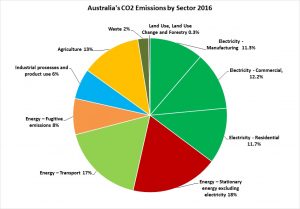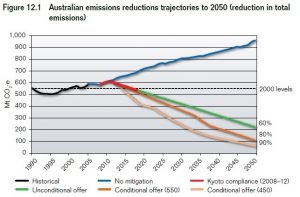27 Feb Can Australians face up to REAL carbon reductions? Part 1
- Introduction
This is the first of a three part blog which will look at a plan for real carbon reductions in Australia’s electricity generating system.
The blog will address
- where Australia’s greenhouse gas emissions come from, what our targets should be,
- how we can achieve them in the electricity sector using nuclear energy and
- where nuclear power plants could be sited in Australia
In today’s blog I’ll address our sectoral emissions and targets.
- Australia’s Sectoral Emissions

Attribution: Data taken from Quarterly Update of Australia’s National Greenhouse Gas Inventory: June 2016Australia’s National Greenhouse Accounts, Department of Environment and Energy
I don’t think most people recognise the scale of the challenge required to decarbonise and many think it is limited to their domestic electricity use.
This pie chart hopefully clears that up. It shows in the darker green colour emissions from our Electricity Generating system which makes up about a third of our emissions.
Then in red we have the Stationary energy sector such as gas burning in industry or diesel in mining generators. This accounts for 18% of emissions.
Next in light green we have Transport. It’s good for 17%.
Finally we have the mix of fugitive emissions such as gas from mines and Agricultural emissions such as methane from animals or fuel use in tractors.
Some sectors are more easily decarbonised than others. Transport is difficult because we seem to be addicted to their use of private cars and increasingly fuel thirsty SUV’s and just love air travel.
Industrial processes such as cement and steel production are difficult to decarbonise because at present coal is used in steel and cement manufacture but this can be overcome.
Our love of red meat contributes to very large emissions from our agricultural sector and so one day without red meat saves a similar level of emissions to one day of 100% zero carbon electricity.
The electricity generating sector should be the easiest of all sectors to decarbonise. After all, the generators are fixed in place and don’t move around unlike cars and cattle. Additionally we actually know how to do it and the precedent has been set. France, Sweden, Switzerland who all have emissions down around 50 gr CO2/kWh or below.
Australia on the other hand has emissions 16 times this low level at around 800 gr CO2/kWh. To try to fix this we have played around with wind power for example. It’s been used in Australia for 31 years but still produces less than 6% of our electrical energy and is a massive consumer of non-renewable resources.
- Australia’s emissions trajectory

Attribution: From the The Garnaut Climate Change Review, Chapter 12, page 284 with the Australian Government’s recent claimed emissions totals overlain
Figure 12.1 from the Garnaut Climate Change Review shows a range of emissions trajectories that conform to various policies. To achieve our share of a maximum 2 degrees warming we need to be on the Conditional Offer (450) or lower. That means our electricity sector has to have emissions below 50 gr CO2/kWh by 2050 and all other sectors of our economy will have to achieve similar levels of decarbonisation.
By the current Government’s reckoning Australia’s emissions are tracking to meet our watered-down Direct-Action targets shown in the green line however a few important emissions are not accounted for and just a few examples are:
- The ongoing destruction of our industrial base is “off shoring” our emissions. Now that Holden, Ford, Toyota, Chrysler, Nissan and others have all left Australia we have effectively sent these emissions to Asia and Europe. We drive more cars than ever and because they’re getting bigger they produce more carbon emissions than ever.
- In Australia our production of cement, glass, aluminium and steel is falling but we use more of these goods than ever. These are four of the largest emitters of greenhouse gases and as with the motor vehicle industry we continue to send these emissions “off shore”. Likewise the local manufacture of white goods has long since ceased.
- Importantly, fugitive gas emissions are not being properly assessed in our Greenhouse gas accounting and our Department of Environment and Energy acknowledges that. At the levels of gas leakage reported in the USA, emissions from gas plants rival and even exceed those of coal plants.
With Australia’s extremely poor record in addressing emissions reductions across all the sectors just described, it’s vital and completely achievable to reduce those emissions coming from our electricity sector by 90% or more. This time is right to achieve this with a proven way to achieve deep emissions reduction.
This will be covered in my second blog.

Jim Simpson
Posted at 15:30h, 27 FebruaryReducing Australia’s CO2 emissions might make sense Robert. if there were empirical evidence proving the case against CO2 (ie that CO2 is a pollutant & the primary driver of so called CAGW) but there isn’t & you know it.
Your demonization of CO2 (a miniscule atmospheric trace gas necessary for life on earth) does you no credit. It tars you with the same dubious brush of Climate Alarmists, perpetrating a lie to prosecute your own ends. That’s dishonest IMHO.
OTH, if you have such evidence proving the case against CO2, then you should publish it.
Whilst I too subscribe to a nuclear future, I do NOT do so at the expense of perfectly good reliable, affordable & dispatchable energy provided currently via fossil fuels. Technology that we know how to build, is not banned & should be progressed ASAP to replace our ageing fleet of coal fired power stations.
Longer term, yes, we should indeed get the ridiculous ban lifted on nuclear technology in Australia so it can stand on its own two feet in fair & transparent competition with ALL forms of energy generation. Let the free market decide which sources of energy they elect to use (technology neutral), uninhibited by financial subsidies for one & not the other.
Meantime, you & other followers here’ could do worse than make an effort to read The Great Climate Debate – An inconvenient truth Exposed by Tom D Tamarkin – here https://greatclimatedebate.com/?fbclid=IwAR1Hx2KfiIGXgxL8UmCvdDzYsni-0KQQPP2t6iDcTWRFJv1IEemPYJzjxUo – enjoy.
Jim Simpson
Convenor, Climate Realists of Five Dock
Jim Simpson
Posted at 11:58h, 01 MarchYes – I think there are those among us Anton who do “..care if it for the wrong reason”.
The abuse of science is evident in many quarters nowadays (not least in respect of the ongoing demonization of CO2), much to the chagrin of those who hold its principles high above all else.
I can ‘taste’ Robert’s frustration in finding traction for a nuclear future. I, and others within our Group, share it too. But – not at the expense of science that has yet as best as I can judge, failed to deliver empirical evidence proving the case against CO2 – ie that it’s a pollutant & primary driver of so called ‘global warming’. IMHO, riding on the coat tails of dubious science demonizing CO2 leaves something to be desired.
For you and/or others who might doubt the extensive number of peer reviewed scientific papers challenging the case against CO2, & have something to contribute toward the debate, here’s a link to one of but many such on-line discussions (including references to related Papers) that you might care to contribute to http://notrickszone.com/2017/03/13/uncertainties-errors-in-radiative-forcing-estimates-10-100-times-larger-than-entire-radiative-effect-of-increasing-co2/ .
Meantime, I suggest there’s a ‘take home’ message in that Tom Tamarkin Paper that’s perhaps worth revisiting.
Mike Elliott
Posted at 23:54h, 20 MarchI dont think anyone is listening to the Chief Scientist.
Senator MacDonald asked – “If we reduce the world’s carbon emissions by 1.3% [Australias Contribution], what impact would that have on the changing climate of the world?”
Chief Scientist Dr Finkel replied – “Virtually nothing”.
Peter Seligman
Posted at 18:04h, 10 JulyI don’t think that this is any justification for doing nothing. If you asked any voter what impact they would have if they didn’t vote, the answer would also be virtually nothing. Likewise if you divide the world into countries or states, each of which has a tiny impact and the answer would be the same.
But you cannot conclude that there is no point in doing something.